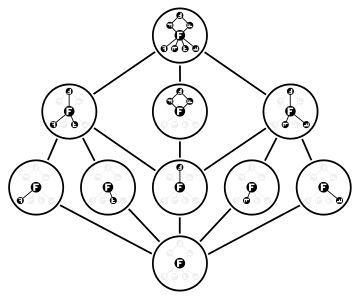Frattini group

Subgroup diagram of the dihedral group D 4 . The three subgroups of order four in the second row are the maximum subgroups. Your cut is the Frattini group. It is one of the five subgroups of order 2.
In group theory , the Frattini group (or more precisely the Frattini subgroup ) is a special subgroup of a given group . With their help, the structure of finite p-groups can be investigated. It is named after the Italian mathematician Giovanni Frattini , who defined it in an article published in 1885.
definition
If a group, then the Frattini group is defined as the intersection of all maximal subgroups of .
Here is a subset of maximum if true and there is no real major subset with there.
If it has no maximum subgroups, for example in the case of the trivial group or some infinite groups such as the examiner group , one sets .
properties
- The Frattini group is a characteristic subgroup , especially a normal part .
- Is finite, then is nilpotent . Is also nilpotent, then is nilpotent too .
- Applies with a subset of , then is .
- The Frattini group consists precisely of the non-producers of , i. That is, it holds if and only if for every subset it always follows. In other words: the elements of the Frattini group are superfluous in every generating system of .
literature
- Bertram Huppert : Finite groups (= The basic teachings of the mathematical sciences. Vol. 134). Volume 1. Reprint. Springer, Berlin a. a. 1979, ISBN 3-540-03825-6 , Chapter III.
Individual evidence
- ↑ Giovanni Frattini : Intorno alla generazione dei gruppi di operazioni. In: Atti della Reale Accademia dei Lincei. Rendiconti. Series 4, Vol. 1, Fasc. 9, 1884/1885 (1885), ISSN 0001-4435 , pp. 281-285 ; Nota II. In: Series 4, Vol. 1, Fasc. 14, 1885, pp. 455-457 .
- ↑ Hans Kurzweil , Bernd Stellmacher : Theory of finite groups. An introduction. Springer, Berlin et al. 1998, ISBN 3-540-60331-X , p. 98.
- ^ Marshall Hall : The Theory of Groups . The Macmillan Company, New York NY 1959, pp. 157 .














